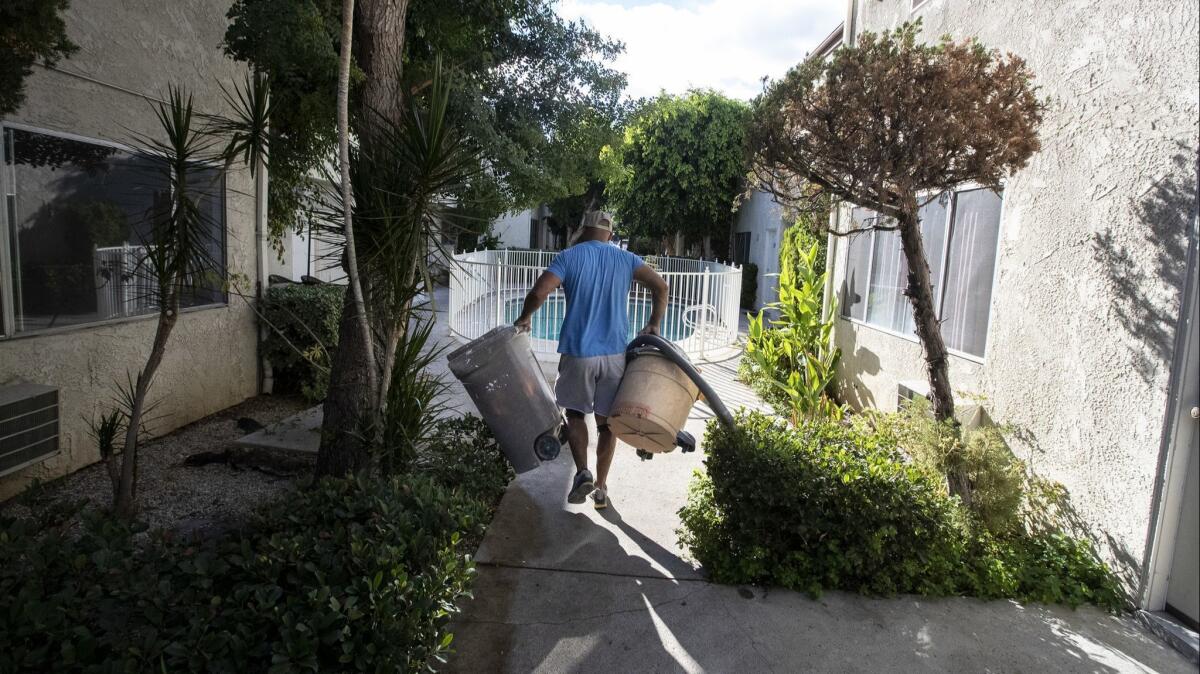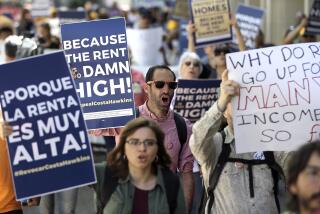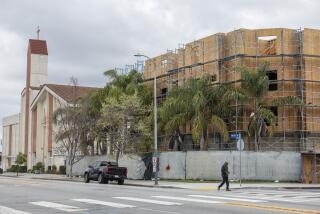Editorial: California renters need relief. That means weakening Costa-Hawkins

- Share via
Over the last few years, California’s elected officials have finally gotten serious about fixing the housing shortage that is eroding the quality of life here. Lawmakers have passed bills to streamline the development of housing in urban areas and to make it harder for cities to block much-needed housing construction. Voters have approved billions of dollars in new spending to subsidize affordable homes.
And there are more bills pending in Sacramento to boost the supply of housing, which is absolutely essential after many years during which the state failed to build enough units to keep up with population growth.
But the focus on increasing housing supply has overshadowed other reforms designed to help struggling Californians now. Among other things, it is increasingly clear that lawmakers can’t address the real-time pain and upheaval caused by the state’s housing crisis without strengthening tenant protections.
Rent control is not the answer to California’s affordability problem. It’s a tool to deal with the consequences of that problem.
Now, a group of Democratic lawmakers has proposed a package of bills aimed at protecting renters, including proposals to cap annual rent increases and to make it harder to evict tenants without just cause. The bills will inevitably be controversial — any discussion of rent control is — but legislators shouldn’t shy away from adopting reasonable policies designed to provide stability and security for renters, who make up nearly half the state’s population.
The most contentious proposal is likely to be Assembly Bill 36, which would weaken the Costa-Hawkins Rental Housing Act, a 1995 law that restricts cities’ ability to enact or expand rent control. Costa-Hawkins bars rent control on apartments built after 1995 (or earlier in cities that already had rent control in place, such as Los Angeles, where the cutoff is 1978.)
Last year, voters rejected Proposition 10, which would have repealed Costa-Hawkins entirely. Now, Assemblyman Richard Bloom (D-Santa Monica) wants to modify it instead, giving cities the option of adopting “rolling rent control,” which would slowly expand the number of regulated units by applying rent control to properties as soon as they turned 10 years old.
The reason for the 10-year delay is that there’s general agreement that applying rent control to new buildings could inhibit housing development. But is 10 years the right trigger? Or 15 years or 20 years? There’s room for negotiation.
AB 36 would also allow cities to impose rent control on single-family homes and condominiums. That is currently prohibited by Costa-Hawkins as a way to protect mom-and-pop landlords. Under the bill, rent control would apply only to single-family homes when landlords own three or more rental properties.
Only a dozen cities in California currently have rent control laws, although the number is growing. The Los Angeles County Board of Supervisors and the Inglewood City Council recently approved temporary, emergency rent control laws as a way to slow rapidly rising rents and evictions, particularly in gentrifying neighborhoods where long-time renters fear being priced out.
Another piece of the package in Sacramento is AB 1482, an attempt to stop the most exorbitant rent hikes by imposing statewide “anti-gouging” rules, similar to what Oregon passed earlier this month. The bill by Assemblyman David Chiu (D-San Francisco) would set a cap, at a level still to be determined, on annual rent increases that exceed inflation. The goal is prevent the kind of excessive rent hikes that can force people from their homes.
Enter the Fray: First takes on the news of the minute »
To prevent landlords from evicting tenants in order to get around rent caps, Assemblyman Rob Bonta (D-Alameda) has proposed AB 1481, which would require landlords to show “just cause” — such as failure to pay rent or a lease violation — before they could oust a renter. Lastly, Assemblywoman Buffy Wicks (D-Oakland) has proposed AB 724, which would require landlords to report data about their property and rentals in order to create a statewide registry. The idea is to use the data to track trends on rents and evictions.
All these bills will be controversial because they impose new requirements and restrictions on landlords. There’s always a concern — reasonably — that overly strict regulations will make it impossible for landlords to earn a reasonable rate of return and will push them out of the rental business, or that tough new rules will deter developers from building new rental housing in California. That would diminish supply and drive up prices.
Yet there’s no escaping the fact that rents are rising much faster than incomes. Too many Californians are living on the edge financially, one rent increase or eviction away from homelessness. Rent control is not the answer to California’s affordability problem. It’s a tool to deal with the consequences of that problem, and to provide some measure of stability for renters during the state’s inevitable boom-and-bust real estate cycles.
Follow the Opinion section on Twitter @latimesopinion and Facebook
More to Read
A cure for the common opinion
Get thought-provoking perspectives with our weekly newsletter.
You may occasionally receive promotional content from the Los Angeles Times.










